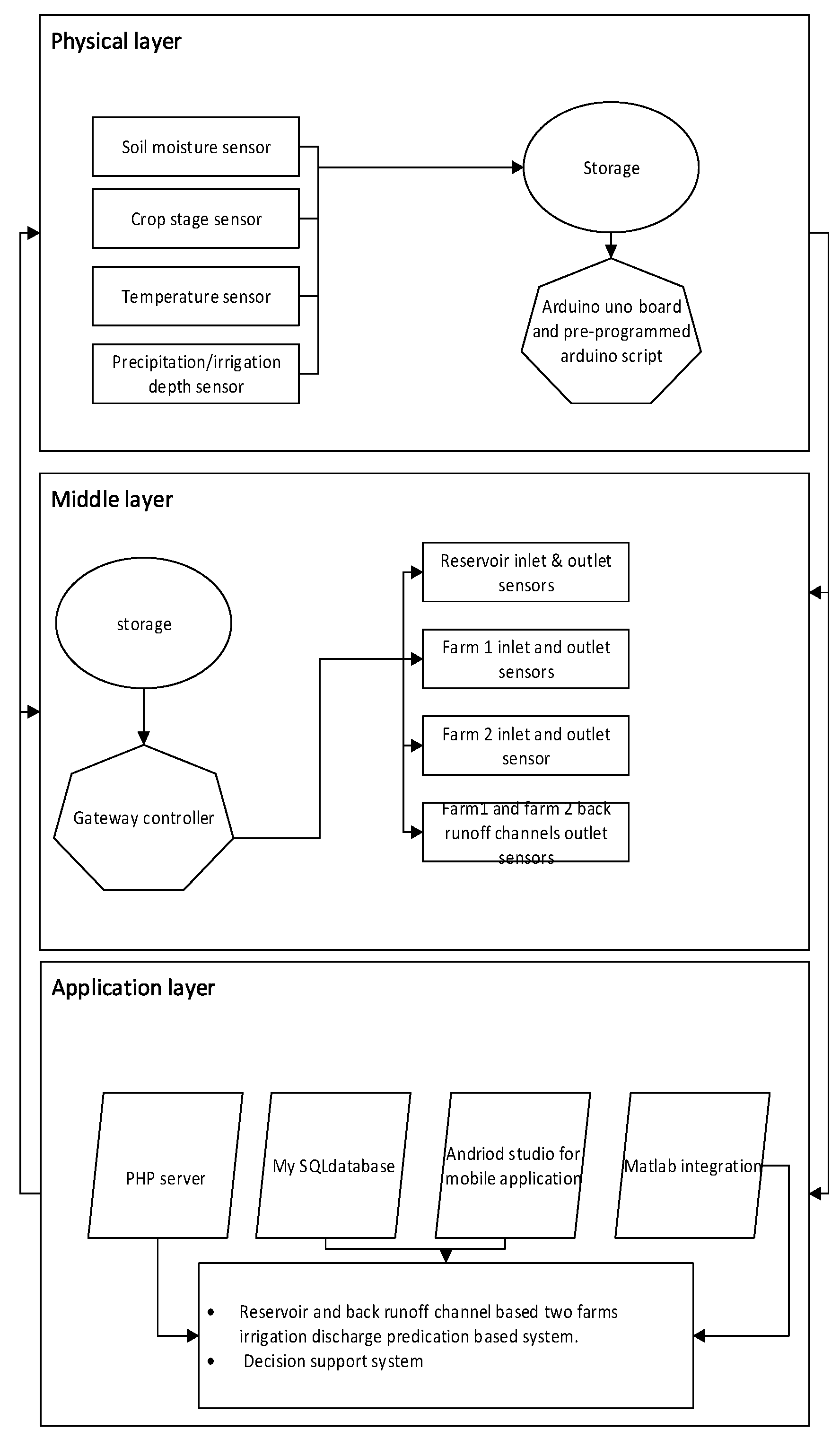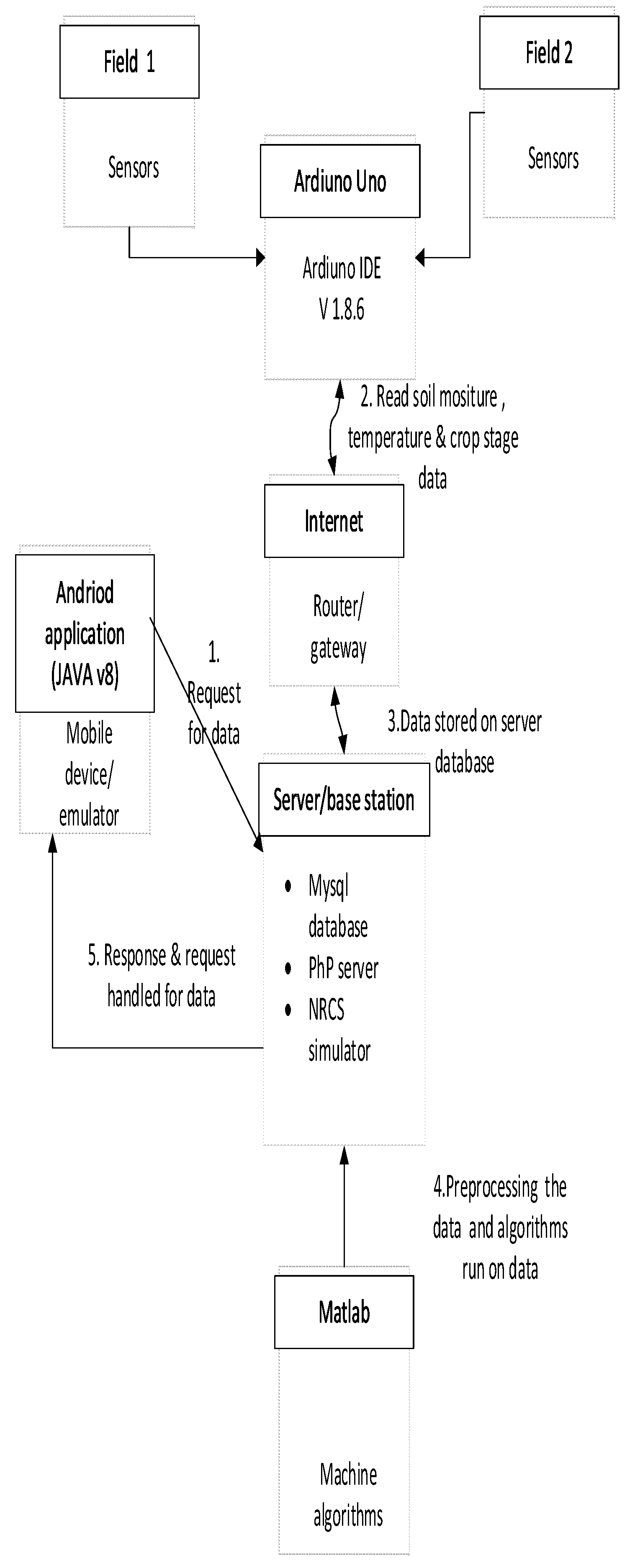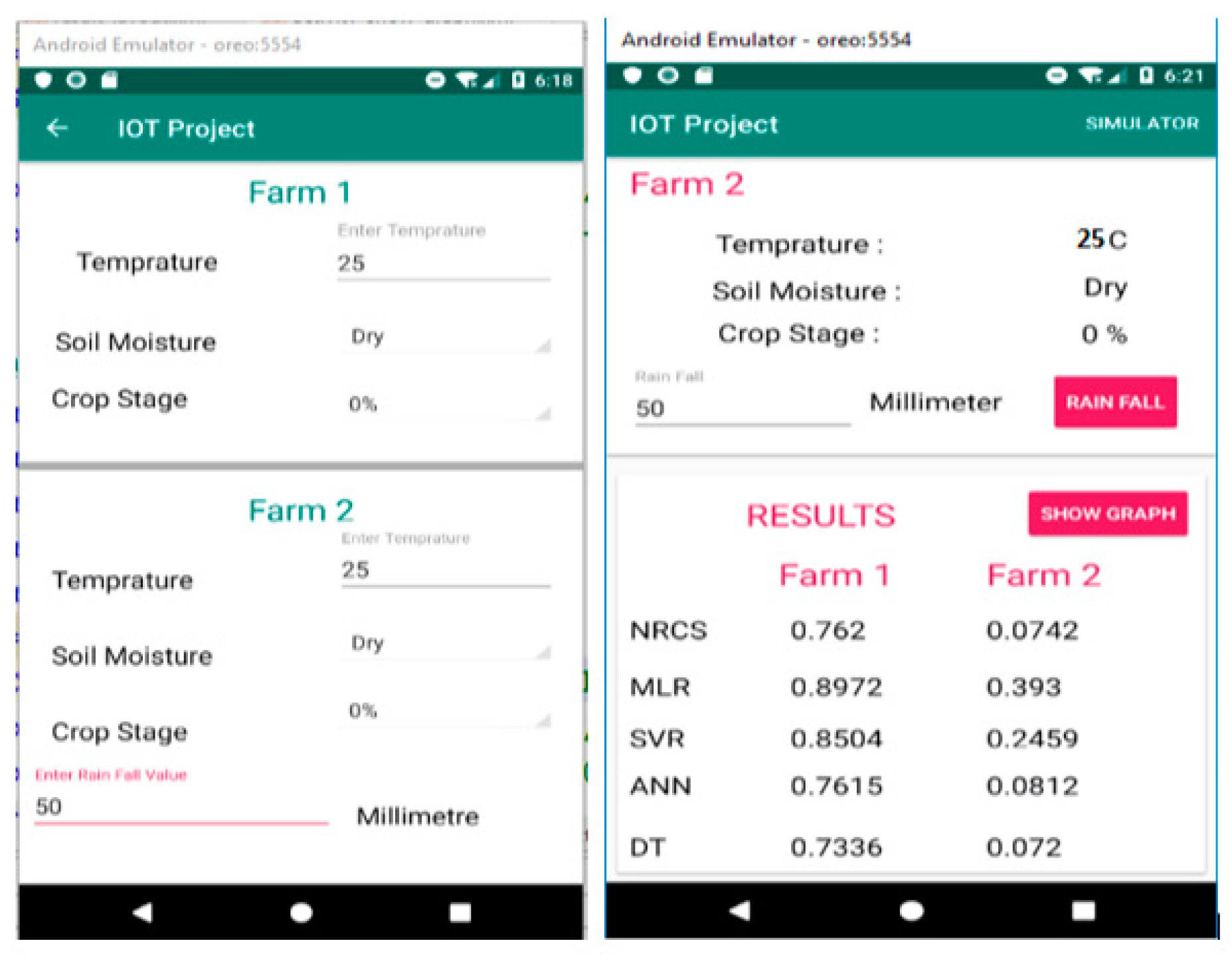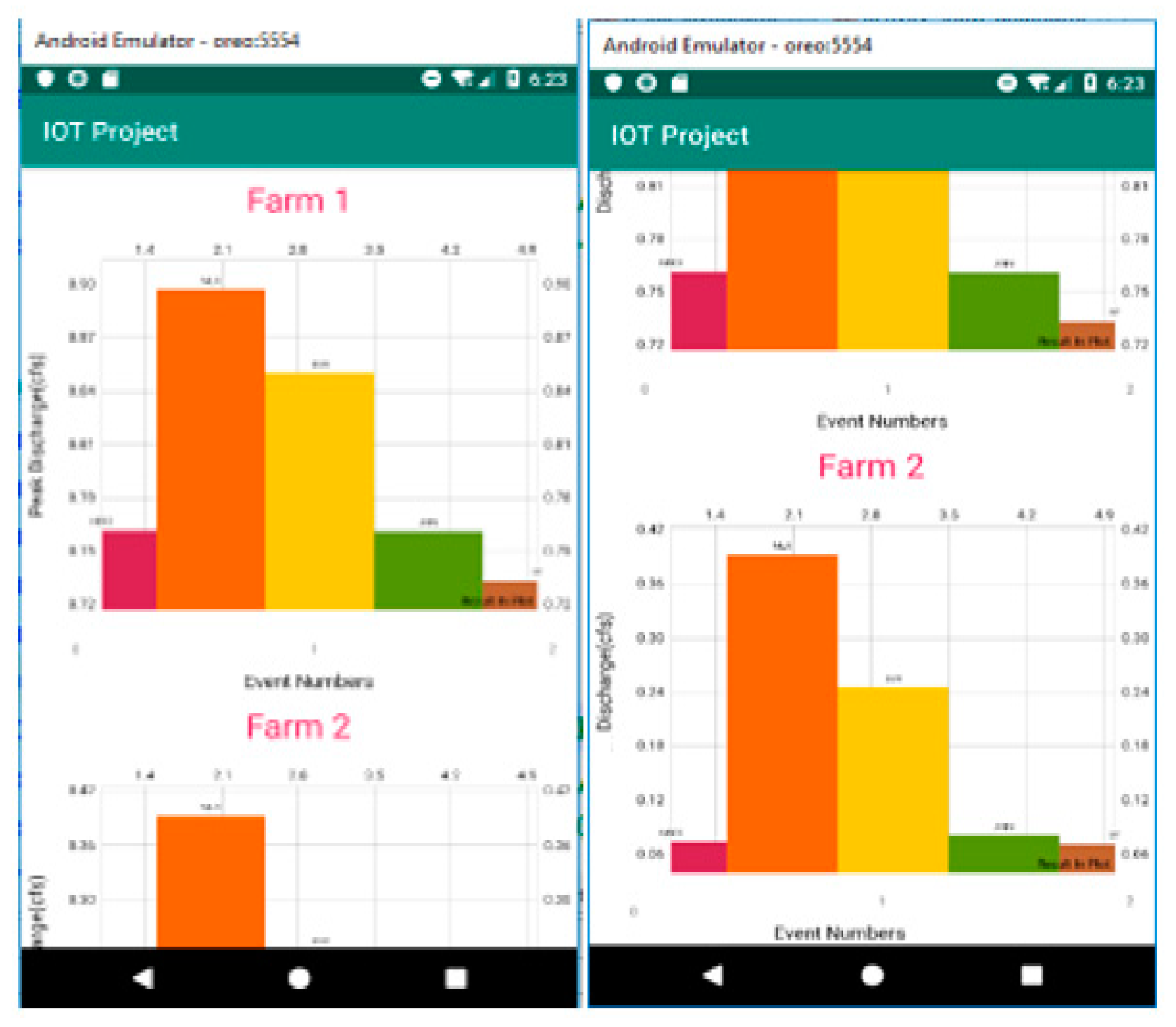I. Introduction
Global Climate change and increase in the world population has tremendous impact on the world's agricultural sector . The agriculture sector must meet the food security challenge of the growing population of the world which is almost estimated as 9.15 billion people on the year 2050 according to the UN population projections. There are two important variables for food security to achieve in the agricultural sector, the first is land resource and the second is water resource. Most of the world land resource is either under the forest or far away from human communities and not suitable for the cultivation purpose. Alot of land cultivation is done by rainfed as it covers 80% of the global agricultural cultivated land and output 60 % of crop production, less on irrigation which is about 20 % cultivated (arable) land but as due to the global warming the patterns of rainfall changes and those regions which have less rainfall or droughts now needs to be switched to modern forms of smart irrigation. Smart irrigation can increase land cultivation in the parts of the world such as in Africa and middle east where there is less rainfall and water scarcity. Water is the fundamental resource for the food production in agriculture [
1].It is worth to note that 70% of Global fresh water goes into agriculture sector, 11 % to industrial and 8% to municipal. However due to water mismanagement methods such as flooding/surface irrigation . on the global scale irrigated area such as flooding covers 75 %, micro irrigation 7% and sprinklers 18% [
2].
In china, India and Pakistan which have the largest irrigation land uses the method of flooding for the cultivation purpose [
3]. Water mismanagement needs to be resolved and there is a great potential for these countries which are switching to micro irrigation systems ( such as drip and sprinkler also known as precision irrigation) in order to save the water waste. Precision irrigation system is fully automatic, uses different wireless sensors such as soil moisture, crops, temperature, precipitation, humidity and solar monitoring and so many other related parameters of agriculture system . Precision irrigation reduces labor cost, and provide informed decision on the basis of data it has elicited from different sensors and an informed decision has to be carried out to the end users(that could be the stackholders of the agriculture system such as( agricultural system analyst, farmers etc) [
4].
III. Research methodology
In this research methodology the problem of how to save the water that has been wasted through surface runoff from one farm to another farm from irrigation or rainfall . the solution provided is the use of wireless sensor network (WSN), internet of things (IOT), Machine learning algorithms for proactively predict the runoff estimation that could be reuse in the other farm or reroute back to the reservoir for future use . For giving an easy interface for endusers (system analyst, farms),Mobile based application has been developed which rendered the farms environmental status as well as predicated values of total discharge at the farms outlets on the basis of sophisticated machine learning algorithms. Then the algorithms performance has been analyzed and compare against the NRCS simulator based predicated value for total discharge at farms outlets.
A. WSN and machine learning deployment in real world (AIOT)
AIOT (Artificial intelligence and Internet of Things) and Andriod mobile based application is developed and integrated which will help the user to retrieve the status of two farms on mobile device. Data is retrieved from arduino soil moisture sensor and temperature sensor (LM35 arduino sensor).while for crop stages proxy values are assigned to the model which is constituted on NRCS and TR 55 document on small watershed for urban hydrology to reflect on real world values for crop stages such as fallow land, small grain less than 50 percent cover and small grain with 75 percent surface cover [
12]. The precipitation values are feeded into the system from the local meteorological site available on the mobile samsung that is connected with Accuweather [
13].The data is further analyzed and the current condition of farms are being displayed on mobile. On the physical layer WSN nodes are deployed on two farms for data elicitation from the real world, While Machine learning is used on application layer for the decision making that how much total amount of water is discharged. The predication for total discharge (cfs) is developed at farms outlets. While in the middle layer such as gateway is responsible for inlet and outlets sensors of reservoir, farms and farms back runoff channels to open and close the flow paths after the decision making on the application layer. The below figure provide a diagrammatic representation of physical, middle and application layer.
Figure 1.
Physical, middle and application layers overview.
Figure 1.
Physical, middle and application layers overview.
The real challenge is that how precision irrigation system and WSN deployed on the two farms save water waste, energy and also is cost effective.
There are various climatic, soil moisture and crop growth development parameters to be measured on these sensor deployed on the farms for onward processing and decision making to be taken on machine learning at the application layer.
B. Experimental setup
The connected nodes to the arduino Uno device, a Large number of nodes are scattered through a geographic agricultural location to monitor environmental and soil parameters that can affect the irrigation process. Some important nodes of our developed system are discussed as follow: soil moisture, irrigation(water flow sensor) /precipitation sensor, temperature sensor and crop stage sensor. [
14]
The fundamental node to monitor and estimate the soil moisture of a farm is mandatory because it will help to know that how much water is required by the plants to be provided by the irrigation system. When the soil moisture of the farm is known in prior a specific amount of water should be provided to save water waste. The soil moisture sensor that has been used with the arduino Uno board is the arduino soil moisture sensor. [
15]
The weather node is responsible for monitoring the environment, there are various types of sensors to monitor the environments that are humidity, temperature, windspeed, solar radiation etc.
However, Air temperature to monitor has a crucial impact on the crops growth, low air temperature there is less water absorption and movement of water in plants.
“The LM35 series are precision integrated-circuit temperature devices with an output voltage linearly proportional to the Centigrade temperature..” (LM35 Precision Centrigrade) LM35 is three terminal linear temperature sensor from National semiconductors. [
16]
Pole mounted Multispectral/hyperspectral camera connected with arduino The pole mounted camera can be placed horizontally to arduino uno or pole mounted vertically to take crop images . [
17]
For precipitation measurement the local meteorological site available on the cell phone has taken into consideration which uses international integration of radars based system and other relevant parameters for quantitative estimation of precipitation over a region. [
18]
Irrigation(water flow sensor) is also taken into account and used its values interchangeably in the mobile based application against precipitation values for ease . [
19]
C. Base Station
Base station is referred as a centralized component that is specifically used for the data elicitation from the different sensor nodes attached to arduino uno, In the experimental setup the base station is composed of two further components that is a laptop and a gateway mote. The laptop runs on windows operating system. whenever the data is received by the base station /laptop from the gateway mote which in turns receive data from different nodes of arduino uno boards, the laptop has various WSN based software (arduino IDE ) and machine learning algorithms Script for the real world data processing and execution to provide intelligent decision support system by predicating total discharge at the farms outlets level.
D. IOT based model practical setup on two neighbouring farms
A practical setup on the farms has been carried out by the implementation of different sensor nodes for soil moisture based on arduino (Decagon EC 5), temperature sensor (LM35) and crop camera CCTV that must be atttached to a pole and connected to arduino uno board for the two nearby adjacent farms.
The point-to-point topology of the two neighbouring farms A and B which has been considered in this experimental setup.
For fallow land (crop stage 1 ) mean 0 % surface cover, when soil moisture condition is dry . the data from the soil moisture, crop stage and temperature is rendered from sensors installed in the fields and precipitation depth value is given from the local meteorology data available on mobile app by the end user.
For small grain (crop stage 2) means that the land is covered with < 50 surface cover and here soil moisture condition is dry as well.
For small grains with = > 75 % surface cover (crop stage 3) with dry soil moisture condition . The sensors for temperature, soil moisture and crop camera ardiuno is installed in the fields and are able to have Ethernet connection as well as wifi connection between ardiuno uno boards installed on two fields 1 and 2.
E. AIOT design diagram
The AIOT
Figure 2 below shows that how two farms are connected with each other through different agricultural and environmental sensors through arduino microcontroller. A list of these sensor is given in the results and discussion section . It also shows that how machine learning is used in the hydrological modeling . How the mobile based application came into existence for this hydrological modeling of the two farms is also discussed . A compressive overview is given in the results and discussion section .
IV. RESULT AND DISCUSSIONS
The following tools are used in this research work to obtained the data, storing, processing and displaying to the end users are as follow.
Wireless sensors (IOT), It contains various field sensors and ardinuo uno board, the sensors are connected to the ardinuo board. it provides the feature for wireless communication with other other arduino board .
Internet is used as gateway for the communication purpose.
The Xampp server is installed which can act as local server and live server, developed by apache friends, consists of apache http server, mariaDB data base (derived from mysql) and read scripts written in php and perl . The data request is then forwarded to the arduino uno which has been configured by ardiuno IDE V1.8.6 and relevant arduino sensors for temperature, crop stage, water flow sensor and soil moisture through a router/gatway
JAVA v8 is used for the mobile application development.
Matlab tool is used for machine learning algorithms predications and NRCS simulator results.
A. Mobile emulator results for dry condition
In this emulator results the data is retrieved from soil moisture sensor, crop stage sensor, temperature sensor and precipitation sensor/ irrigation water flow sensor, both the fields 1 and 2 have dry conditions and crop stage one. Here crop stage means fallow land (0 % surface cover).
The values for precipitation/irrigation can be given in the range of 0 to 100 millimeter numeric values in the mobile emulator for both farm 1 and farm 2 . The temperature is in the range of 0 to 50 centigrade. The other soil moisture conditions are dry, average wet, wet and extreme wet while the crop stages are crop stage 1 (0% surface cover), crop stage 2 ( 50 % surface cover) and crop stage 3 (>=75 % surface cover).
Figure 3 below shows farm 1 and farm2 initial variables such as temperature, soil moisture, crop stage and precipitation or irrigation value variable in millimeter for both field 1 and field 2 and also shows the results for total discharge predication in the numeric values for farm 1 outlet on the basis of NRCS, MLR, SVR, ANN and DT and similarly for farm 2.
Here
Figure 4 below shows the total discharge values against event numbers for farm 1 and farm 2 in bar graphs form.
The X–axis represented in the below
Figure 5 shows bar graph for farm1 Event numbers (sample numbers/ tuple numbers which is in the range of 0 and 2 that is equal to 1) while the Y-axis shows the discharge in cubic feet per second (cfs).
Figure 5.9 shows that the NRCS value for total discharge predication is closely predicated by ANN, then followed by DT however SVR and MLR predication is not that closer to the NRCS predication value for total discharge.
Similary
Figure 6 shows that the NRCS predicated value for discharge at farm2 outlet is closely predicated by ANN, followed by DT, however SVR and MLR predication is not that closer to the NRCS value. . Both SVR and MLR shows a high rise away from the NRCS predicated value in the bar graph.
The other conditions are Average wet, Wet condition and extreme wet for soil mositure, crop stages (1= fallow 0%, 2= small grain < 50%, 3= small grains=>75%) and the range of values for the precipitation temperature from 0 to 50 .
B. Tabulated results of machine learning algorithms and NRCS simulator.
In the below table a tabulated summary is given that Artificial neural network (levenberg-Marquardtt), Decision tree (regression tree), Support vector machine (SVR) and Multiple linear regression has been used for total discharge predication at farms outlets . In which ANN performed outstandingly well than the rest of algorithms in this hydrological predication of total discharge as compared with the natural resource conservation service (NRCS) based simulator . The algorithms are ranked on the basis of performance accuracy . In the table there is also mentioned the key advantages that is associated with the deployment of this system on full scale.
Table 1.
Representation of ML algorithms, NRCS simulator, comparison, ranking and its advantages.
Table 1.
Representation of ML algorithms, NRCS simulator, comparison, ranking and its advantages.
| ML learning algorithms used |
Hydro simulator |
RANK of algorithm for Total discharge predication at both farms |
Inputs parameters |
Advantages |
| ANN |
NRCS |
Ist |
Soil moisture |
Save water waste and avoid flooding |
| DT |
NRCS |
2nd |
Crop stage |
Low labor cost |
| SVM |
NRCS |
3rd |
Temperature |
Full automatic |
| MLR |
NRCS |
4th |
Rainfall/ irrigation |
Efficient and ease of use for enduser. |
V. Conclusion
This paper presents a breif overview that how IOT based sensors for agriculture such as soil moisture, crop stages, temperature, perception and machine learning techniques such as ANN,DT, SVM,MLR are to be integrated on two farms scale for the predication of total discharge at the farm 1 and farm 2 outlets respectively . The broader purpose is to save precious water, reduce labor cost, make the system fully automatic, efficient and also to reroute the saved water on the basis of back runoff channels to the reservoir from these flow channels, which will have its own IOT based sensor for opening and closing the paths. Thus the reroute water to the reservoir can be utilized for further irrigation of these farms incase of droughts the water from one farm can be reutilized in other farm irrigation according to the local farm environment and the flooding will be prevented in the case of excessive rainfall .The state of the art machine learning techniques such as ANN(levenberg-marquardt), DT (regression tree), SVM( regression ) and MLR has been used for this rainfall / irrigation based hydrological modeling over a two large farms scale region. In this hydrological modelling the machine learning techniques that is ranked first is ANN, ranked 2nd is DT, ranked 3rd is SVM and ranked 4rth is MLR. Further there is a need felt to have an Andriod -Ardinuo based mobile application for the endusers such as agriculture system analyst and farmers to be informed about the status of their farms well on time and ease of understanding of multiple scenarios that could be erupted. The mobile application shows the rendered data of farms agriculture parameters such as soil moisture, crop stages, temperature, precipitation/irrigation and the total discharge predication for farm1, farm 2 and the total discharge predicated by machine learning models as well as NRCS predication value for total discharge and thus outclass the rest of algorithms. The results are also shown in the bargraphs form by the mobile application for ease to the endusers.
Acknowledgments
The first author worked on the detail conceptualization for smart farms hydrology, data engineering, machine learning model predications and mobile development, The second author worked in conceptualization,NRCS simulation and Validation of data and research paper lay out and paper presentation. The first author worked in Matlab simulation environment as well while The second author worked in the local base station/live base station setup Xampp server. Finally the work is integrated in presented in this research article.
References
- Nikos Alexandratos and Jelle Bruinsma, "World agriculture towards 2030/2050:the 2012 revision," Food and Agriculture Organization of the United Nations (FAO), Rome, ESA Working Papers 12-03 2521-1838, June 2012.
- Lior Peleg. (2021, Feburary) Netafim. [Online]. https://www.netafim.com/en/blog/from-rainfed-to-irrigated-agriculture/.
- Andreas et al, "Irrigation of world agricultural lands: evolution," Water, vol. V, no. 12, pp. 1-50, May 2022.
- Sabrine et al, "Precision irriation based on wireless sensor network," IET sciences, measurement and technology, vol. VIII, no. 3, pp. 98-106, January 2014. [CrossRef]
- Brady Shearan, Fowzia Akhter, and S.C. Mukhopadhyay, "Design and development of an IoT-enabled sensor node for agricultural and modelling applications," in Sensing and Technology, Australia, 2022, pp. 217-229.
- Marwan Khan and Nick Harris, "Optimal reservoir and back runoff channels based two farms irrigation total discharge predication system," International Journal of Advanced Research in Engineering and Technology (IJARET), vol. XI, no. 10, pp. 837-848, October 2020.
- Nguyen et al, "IOT-enabled smart agriculture :architecture,applications,and challenges," Applied Sciences, vol. VII, no. 12, p. 3396, March 2022. [CrossRef]
- Marwan Khan and Sanam Noor, "Performance analysis of regression-machine learning algorithms for predication of runoff time," Agrotechnology, vol. VIII, no. 1, pp. 1-12, March 2019. [CrossRef]
- Marwan Khan and Sanam Noor, "Irrigation runoff volume prediction using machine learning algorithms," European International Journal oOf Science and Technology, vol. VIII, no. 9, pp. 1-23, January 2019.
- Marwan Khan, "Infrastructure and environment," in CDT-SIS conference-university of southampton, Southampton,UK, 2017, p. 19.
- Jirapond et al, "IoT and agriculture data anaylsis for smart farm," Computer and Electronics in Agriculture, vol. 156, no. 1, pp. 467-474, January 2019. [CrossRef]
- USDA. (1986, June ) Urban hydrology for small watersheds. document.
- AccuWeather. (2016, Feburary) AccuWeather. [Online]. https://www.accuweather.com/en/press/55586116#:.
- Pushkar Singh and sanghamitra Saikia, "Arduino-based smat irrigation using water flow sensor,soil moisture sensor,temperature sensor and ESP8266 wifi module," in IEEE Region 10 Humanitarian Technology Conference (R10-HTC), India, 2016, pp. 1-4.
- Jose et al, "An Arduino-based wireless sensor network for soil moisture monitoring using Decagon EC-sensors," Open Journal of Soil Science, vol. VII, no. 10, p. 13, October 2017. [CrossRef]
- Md AshifuddinMondal and Zeenat rehena, "IoT based Intelligent agriculture field monitoring system," in 2018 8th International Conference on Cloud Computing, Data Science & Engineering (Confluence), Noida,India, 2018, p. 7.
- Jeonghwan Hwang, Changsun Shin, and Hyun Yoe, "Study on an agricultural environment monitoring server system using wireless sensor networks," Sensors, vol. X, no. 12, pp. 11189-11211, December 2010. [CrossRef]
- Jian et al, "Multi-Radar multi-sensor (MRMS) quantitative precipitation estimation: initial operating capabilities," Bulletin of the American Meteorological Society, vol. XCVII, no. 4, pp. 621-638, Apirl 2016. [CrossRef]
- M.Usha Rani and S. Kamalesh, "Web based service to monitor automatic irrigation system for the agriculture field using sensors," in 2014 International Conference on Advances in Electrical Engineering (ICAEE), Vellore,India, 2014, p. 7.
Author biography
 |
| Mr: Marwan khan has done his master in information technology from university of Malakand, Pakistan in 2007 . He is working as lecturer in department of computer science awkum from 2013. He purse his higher studies from university of Southampton united kingdom and got the degree of Mphil in computer science in 2002 . He has published number of research articles and have conference presentation in Southampton university Uk. His research interest are machine learning, WSN, IOT, mobile application and digital agriculture. |
| Ms: Sanam noor has done his Mphil in computer science from agricultural university,kpk Pakistan . She is currently working as Associate professor in computer science in Govt degree college batkheila . Her research interests are WSN, Datamining .She has published a number of articles in renowned journals. |
|
Disclaimer/Publisher’s Note: The statements, opinions and data contained in all publications are solely those of the individual author(s) and contributor(s) and not of MDPI and/or the editor(s). MDPI and/or the editor(s) disclaim responsibility for any injury to people or property resulting from any ideas, methods, instructions or products referred to in the content. |
© 2023 by the authors. Licensee MDPI, Basel, Switzerland. This article is an open access article distributed under the terms and conditions of the Creative Commons Attribution (CC BY) license (http://creativecommons.org/licenses/by/4.0/).











